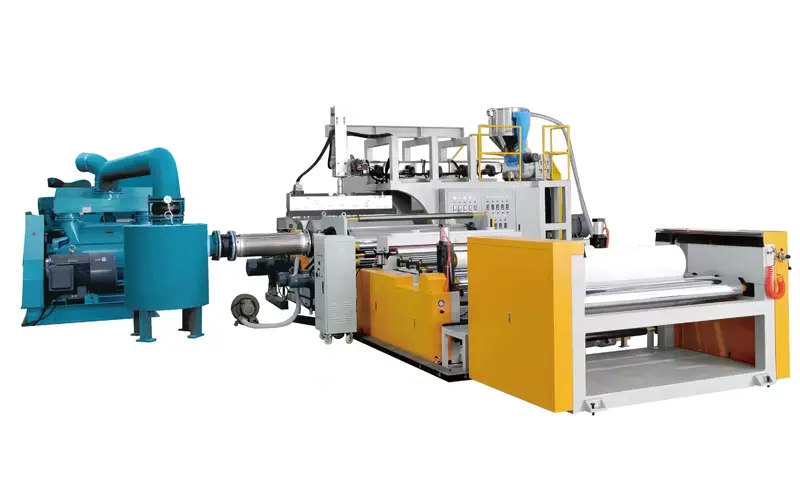PE perforated film production lines produce microporous polyethylene film, a functional material. Leveraging its unique breathable but waterproof (or selectively permeable) properties, it finds applications in numerous fields:
Agricultural Applications:
Mulching Film: This is one of the primary applications. Perforated mulch film covers the soil surface, providing benefits like insulation, moisture retention, weed suppression, and promoting crop growth. Simultaneously, the microporous structure allows rainwater or irrigation water to penetrate the soil and permits gas exchange (e.g., CO₂) between the soil and atmosphere, preventing root anoxia and reducing disease. Compared to traditional non-perforated plastic film, it is more environmentally friendly (reducing concerns about white pollution, some are degradable) and easier to manage (no need for manual perforation).
Seedling Pots/Trays: Used as containers or liners for seedlings. Its breathable and water-permeable nature promotes root development, prevents root rot, and eliminates the need for pot removal during transplanting, minimizing root damage.
Weed Control Fabric/Horticultural Ground Cover: Laid in orchards, nurseries, flower beds, etc., to suppress weed growth while allowing water penetration and soil aeration.
Greenhouse Liners/Curtains: Used inside greenhouses to regulate humidity and temperature, promote air circulation, and reduce condensation and disease.
Fruit Bags: Some fruit bags utilize perforated film, offering physical protection while allowing some gas exchange.
Packaging Applications:
Fresh Produce Packaging: Used for packaging vegetables (leafy greens, mushrooms), fruits (strawberries, blueberries, cherries), and flowers. The microporous structure creates a microenvironment with high humidity (preventing wilting) and moderate breathability, effectively extending shelf life and reducing spoilage. This is a rapidly growing and significant application.
Food Packaging: Used for foods that need to “breathe,” such as baked goods (preventing moisture condensation), cheese, dried goods (moisture-proof and breathable), either as primary packaging or liners.
Anti-Static Packaging for Electronics: With specific formulations, anti-static perforated film can be produced for packaging electrostatic discharge (ESD)-sensitive electronic components.
Healthcare & Personal Care Applications:
Medical Protective Materials:
Surgical Drapes with Fenestrations: Serves as the breathable layer in disposable surgical drapes/sheets, allowing patient skin to breathe for increased comfort, while the top surface provides a barrier against liquids (blood, irrigation fluids).
Liner/Component for Protective Clothing: Used in areas of protective garments requiring breathability to balance protection and wearer comfort.
Hygiene Products:
Backsheet for Sanitary Pads/Pantiliners/Diapers/Incontinence Care Products: As the backsheet material, its microporous structure allows water vapor (sweat, moisture) to escape, keeping the skin dry and comfortable (excellent breathability), while preventing liquid penetration (leakproof). This is another extremely important core application.
Backing for Medical Dressings: Used as the backing for certain wound dressings requiring breathability.
Construction & Geotechnical Engineering Applications:
Geomembrane/Drainage Materials: Used in foundations, roadbeds, retaining walls, tunnels, etc., as drainage layers or components of composite drainage materials. The microporous structure allows water (groundwater, seepage) to pass through and drain in a specific direction (drainage and pressure relief), while preventing soil particle loss (filtration function). Commonly used in soft ground treatment, subgrade drainage, and waterproofing/drainage for underground structures.
Industrial Applications:
Filter Media Substrate/Component: Acts as a support layer or pre-filter layer for certain gas or liquid filter media.
Battery Separator (Specific Types): Certain specially formulated PE perforated films may be used as separator components in specific battery types, though this is not a mainstream application.
Industrial Packaging/Covering Material: Used for temporary covering or packaging of industrial parts or materials requiring breathability, dust protection, and moisture resistance.
Other Emerging Applications:
Pet Care Products: Such as the backsheet or top sheet for pet pee pads, providing breathable and leakproof functionality.
Eco-friendly Materials: With the development of biodegradable polyethylene technologies (e.g., PBAT+PLA+starch blended modified PE), biodegradable PE perforated film holds promising application prospects in agricultural mulch and packaging, aligning with environmental trends.
In summary, the core value of PE perforated film lies in its controllable permeability to air (vapor) and water. This makes it indispensable in applications requiring a balance between “liquid barrier” and “gas/moisture vapor exchange.” It is most mature and widely used in agricultural mulching, fresh produce packaging, personal hygiene products (diaper/sanitary pad backsheets), and medical protective drapes. Its application scope continues to expand with advancements in material technology and increasing environmental requirements.
Post time: Nov-05-2025


